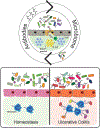Tissues: the unexplored frontier of antibody mediated immunity
- PMID: 33581646
- PMCID: PMC8068598
- DOI: 10.1016/j.coviro.2021.01.001
Tissues: the unexplored frontier of antibody mediated immunity
Abstract
Pathogen-specific immunity evolves in the context of the infected tissue. However, current immune correlates analyses and vaccine efficacy metrics are based on immune functions from peripheral cells. Less is known about tissue-resident mechanisms of immunity. While antibodies represent the primary correlate of immunity following most clinically approved vaccines, how antibodies interact with localized, compartment-specific immune functions to fight infections, remains unclear. Emerging data demonstrate a unique community of immune cells that reside within different tissues. These tissue-specific immunological communities enable antibodies to direct both expected and unexpected local attack strategies to control, disrupt, and eliminate infection in a tissue-specific manner. Defining the full breadth of antibody effector functions, how they selectively contribute to control at the site of infection may provide clues for the design of next-generation vaccines able to direct the control, elimination, and prevention of compartment specific diseases of both infectious and non-infectious etiologies.
Copyright © 2021 The Authors. Published by Elsevier B.V. All rights reserved.
Conflict of interest statement
Conflict of Interest and Disclosures
Dr. Alter is the founder of Systems Seromyx Inc.
Figures






Similar articles
-
COVID-19 Severity Is Associated with Differential Antibody Fc-Mediated Innate Immune Functions.mBio. 2021 Apr 20;12(2):e00281-21. doi: 10.1128/mBio.00281-21. mBio. 2021. PMID: 33879594 Free PMC article.
-
Route of immunization defines multiple mechanisms of vaccine-mediated protection against SIV.Nat Med. 2018 Oct;24(10):1590-1598. doi: 10.1038/s41591-018-0161-0. Epub 2018 Sep 3. Nat Med. 2018. PMID: 30177821 Free PMC article.
-
Topical Tenofovir Pre-exposure Prophylaxis and Mucosal HIV-Specific Fc-Mediated Antibody Activities in Women.Front Immunol. 2020 Jul 6;11:1274. doi: 10.3389/fimmu.2020.01274. eCollection 2020. Front Immunol. 2020. PMID: 32733445 Free PMC article.
-
Extra-Neutralizing FcR-Mediated Antibody Functions for a Universal Influenza Vaccine.Front Immunol. 2019 Mar 18;10:440. doi: 10.3389/fimmu.2019.00440. eCollection 2019. Front Immunol. 2019. PMID: 30949165 Free PMC article. Review.
-
Optimize Prime/Boost Vaccine Strategies: Trained Immunity as a New Player in the Game.Front Immunol. 2021 Mar 8;12:612747. doi: 10.3389/fimmu.2021.612747. eCollection 2021. Front Immunol. 2021. PMID: 33763063 Free PMC article. Review.
Cited by
-
Artificial Intelligence-Based Counting Algorithm Enables Accurate and Detailed Analysis of the Broad Spectrum of Spot Morphologies Observed in Antigen-Specific B-Cell ELISPOT and FluoroSpot Assays.Methods Mol Biol. 2024;2768:59-85. doi: 10.1007/978-1-0716-3690-9_5. Methods Mol Biol. 2024. PMID: 38502388
-
B cell class switch recombination is regulated by DYRK1A through MSH6 phosphorylation.Nat Commun. 2023 Mar 16;14(1):1462. doi: 10.1038/s41467-023-37205-5. Nat Commun. 2023. PMID: 36927854 Free PMC article.
-
The Importance of Monitoring Antigen-Specific Memory B Cells, and How ImmunoSpot Assays Are Suitable for This Task.Cells. 2025 Feb 5;14(3):223. doi: 10.3390/cells14030223. Cells. 2025. PMID: 39937014 Free PMC article. Review.
-
Bioinformatic and Experimental Analysis of T Cell Immune Reactivity to SARS-CoV-2 and its Variants.Front Bioinform. 2022 May 24;2:876380. doi: 10.3389/fbinf.2022.876380. eCollection 2022. Front Bioinform. 2022. PMID: 36304267 Free PMC article. Review.
-
Monitoring Memory B Cells by Next-Generation ImmunoSpot® Provides Insights into Humoral Immunity that Measurements of Circulating Antibodies Do Not Reveal.Methods Mol Biol. 2024;2768:167-200. doi: 10.1007/978-1-0716-3690-9_11. Methods Mol Biol. 2024. PMID: 38502394
References
-
- Janeway CA Jr How the immune system protects the host from infection. Microbes Infect 3, 1167–1171 (2001). - PubMed
-
- Matzinger P & Kamala T Tissue-based class control: the other side of tolerance. Nat Rev Immunol 11, 221–230 (2011). - PubMed
-
- Okabe Y & Medzhitov R Tissue biology perspective on macrophages. Nat Immunol 17, 9–17 (2016). - PubMed
-
- Medzhitov R Origin and physiological roles of inflammation. Nature 454, 428–435 (2008). - PubMed
Publication types
MeSH terms
Substances
Grants and funding
LinkOut - more resources
Full Text Sources
Other Literature Sources

